engine Hyundai Coupe 2005 Owner's Manual
[x] Cancel search | Manufacturer: HYUNDAI, Model Year: 2005, Model line: Coupe, Model: Hyundai Coupe 2005Pages: 478, PDF Size: 13.44 MB
Page 434 of 478

6OWNER MAINTENANCE
16
!
G100B01L
WARNING:
The transaxle lubricant level should only be checked when the engineis cold to prelude the possibility of personal injury by contact with hot components. NOTE: It is recommended that the manual transaxle lubricant should bechecked by Hyundai authorised re- pairer.
1. To check the transaxle lubricant level, the vehicle should be placed on level ground and the level plug removed with a suitable spanner.
2. If the level is correct, lubricant should begin to drip from the plug orifice. In this case the plug shouldbe replaced.If the level is incorrect, lubricantshould be added until it begins todrip from the plug orifice at which time the plug should be replaced. To Check the Transaxle Oil Level
Park the car on level ground with the
engine off.
1. Using a wrench of the correct size, loosen the oil filler bolt turning it counterclockwise and remove it with your fingers.
2. Use your finger to feel inside the
hole. The oil level should be at itsbottom edge. If it is not, check for leaks before adding oil. To refill the transaxle or bring the oil level up,add oil slowly until it reaches the proper level. Do not overfill.
3. Replace the bolt and washer, screw it in with your fingers and then tightensecurely with the wrench.
AUTOMATIC TRANSAXLE LUBRICANT
G110A01GK-EAT Transaxle lubricant should be changed
at those intervals specified in the ve- hicle maintenance schedule in Sec-tion 5.
NOTE: Automatic transaxle fluid is red
color. As driving distance in- creases, the fluid color turns dark-ish red gradually. It is a normal condition and you should not judge the need to replace basedupon the changing color.
You must replace the automatic
transaxle fluid in accordance withintervals specified in the vehicle maintenances schedule in section 5.
gkfluk-6.p65 11/21/2005, 3:00 PM
16
Page 435 of 478

6
OWNER MAINTENANCE
17
HGK5007
HGK3025-E 1.6/2.0L
2.7L!
To Check the Transaxle Fluid Level Park the car on level ground with the
parking brake engaged. When the transaxle fluid level is checked, the transaxle fluid should be at normal operating temperature and the en-gine idling.
Whilst the engine is idling, apply the
brakes and move the gear selectorlever from "P" to each of its other positions — "R", "N", "D" — and then return to "N" or "P". With the enginestill idling:
Recommended Lubricant
Use only Hyundai Genuine ATF SP- III, DIAMOND ATF SP-III, SK ATF SP-III or other brands approved byHyundai Motor Co., Damage caused by a nonspecified fluid is not covered by your new vehicle limited warranty.
Transaxle Fluid Capacity The fluid capacity of the automatic transaxle is 7.8 litres.
WARNING:
The transaxle fluid level should be checked when the engine is at normal operating temperature. This means that the engine, radiator,exhaust system etc., are very hot so you should exercise great care not to burn yourself during thisprocedure. 1. Open the bonnet, being careful to
keep hands and clothing clear ofany moving parts.
2. Remove the transaxle dipstick, wipe it clean, reinsert the dipstick as far as it will go, then remove it again. Now check the fluid level on thedipstick. It should be in the "HOT" range on the dipstick.
gkfluk-6.p65 11/21/2005, 3:00 PM
17
Page 436 of 478
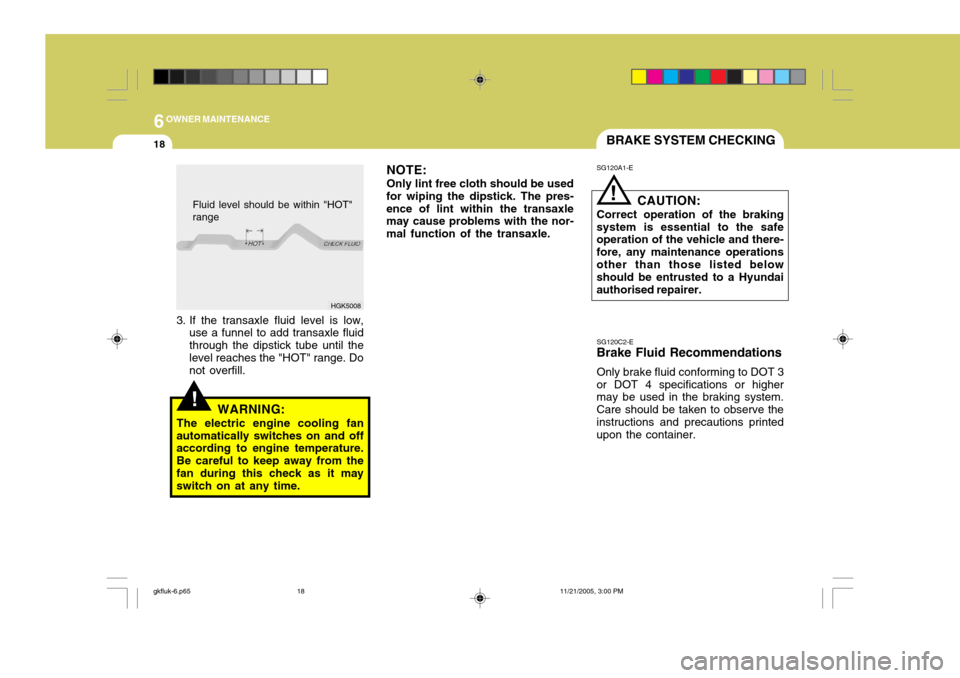
6OWNER MAINTENANCE
18
HGK5008
Fluid level should be within "HOT"
range
!
SG120A1-E BRAKE SYSTEM CHECKING
CAUTION:
Correct operation of the braking system is essential to the safe operation of the vehicle and there- fore, any maintenance operationsother than those listed below should be entrusted to a Hyundai authorised repairer.
NOTE: Only lint free cloth should be used
for wiping the dipstick. The pres- ence of lint within the transaxle may cause problems with the nor- mal function of the transaxle.
3. If the transaxle fluid level is low, use a funnel to add transaxle fluidthrough the dipstick tube until thelevel reaches the "HOT" range. Do not overfill.
!WARNING:
The electric engine cooling fan
automatically switches on and off according to engine temperature. Be careful to keep away from thefan during this check as it may switch on at any time. SG120C2-E
Brake Fluid Recommendations
Only brake fluid conforming to DOT 3
or DOT 4 specifications or highermay be used in the braking system. Care should be taken to observe theinstructions and precautions printed upon the container.
gkfluk-6.p65 11/21/2005, 3:00 PM
18
Page 438 of 478
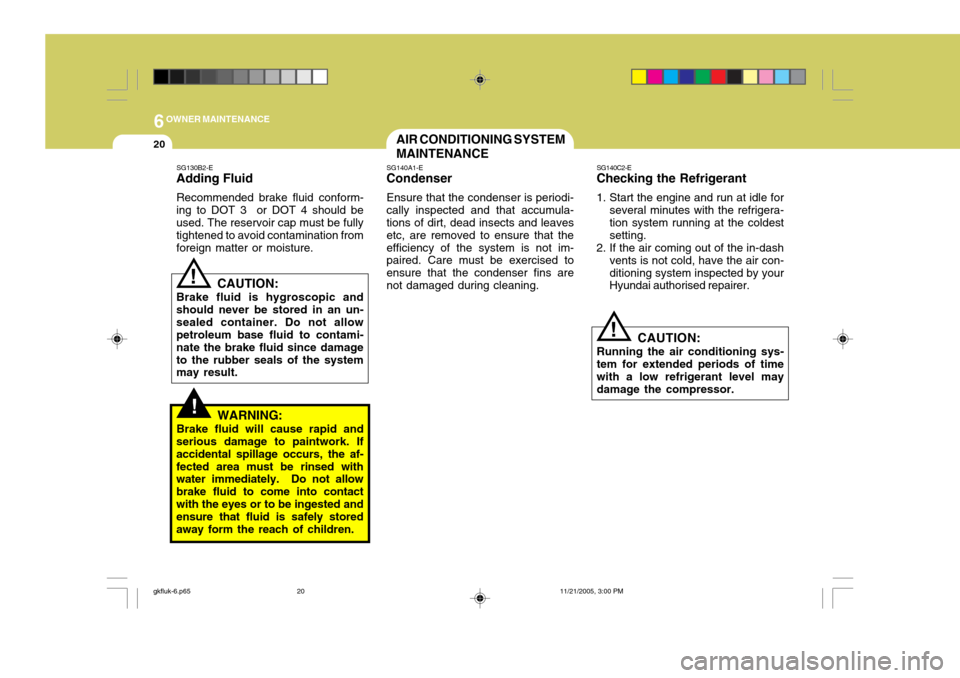
6OWNER MAINTENANCE
20
!
SG130B2-E
Adding Fluid
Recommended brake fluid conform-
ing to DOT 3 or DOT 4 should be used. The reservoir cap must be fully tightened to avoid contamination fromforeign matter or moisture.
WARNING:
Brake fluid will cause rapid and
serious damage to paintwork. Ifaccidental spillage occurs, the af-fected area must be rinsed with water immediately. Do not allow brake fluid to come into contactwith the eyes or to be ingested and ensure that fluid is safely stored away form the reach of children. SG140A1-E
Condenser
Ensure that the condenser is periodi-cally inspected and that accumula- tions of dirt, dead insects and leaves etc, are removed to ensure that theefficiency of the system is not im- paired. Care must be exercised to ensure that the condenser fins arenot damaged during cleaning. AIR CONDITIONING SYSTEM MAINTENANCE
!
SG140C2-E
Checking the Refrigerant
1. Start the engine and run at idle for
several minutes with the refrigera- tion system running at the coldest setting.
2. If the air coming out of the in-dash vents is not cold, have the air con-ditioning system inspected by your Hyundai authorised repairer.
CAUTION:
Running the air conditioning sys-tem for extended periods of time with a low refrigerant level maydamage the compressor.
CAUTION:
Brake fluid is hygroscopic andshould never be stored in an un-sealed container. Do not allow petroleum base fluid to contami- nate the brake fluid since damageto the rubber seals of the system may result.
!
gkfluk-6.p65 11/21/2005, 3:00 PM
20
Page 441 of 478
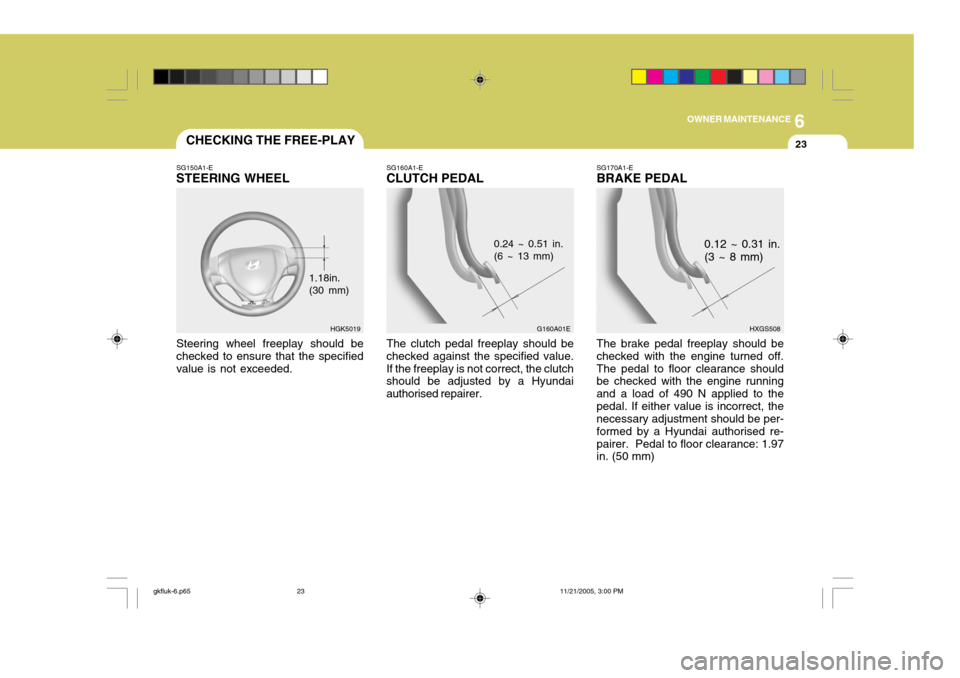
6
OWNER MAINTENANCE
23CHECKING THE FREE-PLAY
SG150A1-E
STEERING WHEEL
Steering wheel freeplay should be checked to ensure that the specifiedvalue is not exceeded. 1.18in. (30 mm)SG160A1-E
CLUTCH PEDAL
The clutch pedal freeplay should be
checked against the specified value. If the freeplay is not correct, the clutch should be adjusted by a Hyundai authorised repairer. 0.24 ~ 0.51 in. (6 ~ 13 mm)
SG170A1-E BRAKE PEDAL The brake pedal freeplay should be checked with the engine turned off.The pedal to floor clearance should be checked with the engine running and a load of 490 N applied to thepedal. If either value is incorrect, the necessary adjustment should be per- formed by a Hyundai authorised re-pairer. Pedal to floor clearance: 1.97 in. (50 mm) 0.12 ~ 0.31 in. (3 ~ 8 mm)
HGK5019 G160A01E HXGS508
gkfluk-6.p65 11/21/2005, 3:00 PM
23
Page 442 of 478
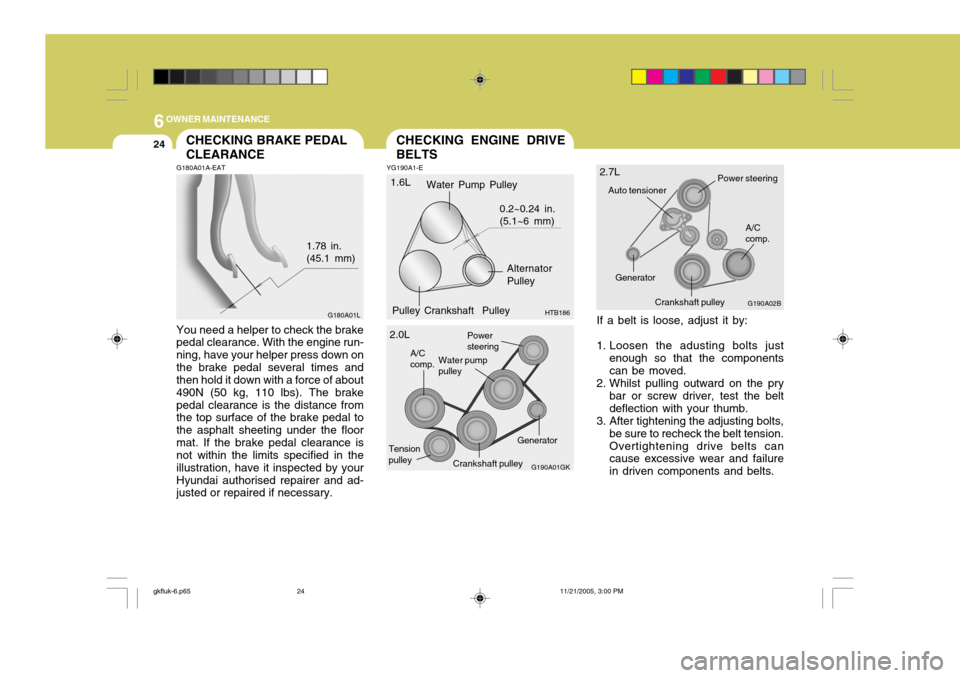
6OWNER MAINTENANCE
24CHECKING BRAKE PEDAL CLEARANCE
G180A01A-EAT You need a helper to check the brake pedal clearance. With the engine run- ning, have your helper press down onthe brake pedal several times and then hold it down with a force of about 490N (50 kg, 110 lbs). The brakepedal clearance is the distance from the top surface of the brake pedal to the asphalt sheeting under the floormat. If the brake pedal clearance is not within the limits specified in the illustration, have it inspected by yourHyundai authorised repairer and ad- justed or repaired if necessary. 1.78 in.(45.1 mm)
YG190A1-E
CHECKING ENGINE DRIVE BELTS
If a belt is loose, adjust it by:
1. Loosen the adusting bolts just enough so that the components can be moved.
2. Whilst pulling outward on the pry bar or screw driver, test the beltdeflection with your thumb.
3. After tightening the adjusting bolts,
be sure to recheck the belt tension.Overtightening drive belts can cause excessive wear and failure in driven components and belts.
G180A01L
Tension pulleyGenerator
G190A01GK
Power steering
Water pump pulley
A/Ccomp.
2.0L G190A02B
A/C comp.
Crankshaft pulley
Power steering
Auto tensioner
Generator
2.7LWater Pump Pulley
Alternator Pulley
Pulley Crankshaft Pulley 0.2~0.24 in.(5.1~6 mm)
HTB186
1.6L
Crankshaft pulley
gkfluk-6.p65
11/21/2005, 3:00 PM
24
Page 445 of 478

6
OWNER MAINTENANCE
27
o If battery electrolyte is spilled onto
skin or into eyes, the effected area must be flushed with copious amounts of water and medical assis-tance sought.
o If battery electrolyte is ingested, copious amounts of water or milkfollowed by an ant-acid (raw egg ormilk of magnesia) must be drunk. Vomiting should not be induced and medical assistance must besought.
o Batteries must only be charged in well venti-lated areas from which naked lights or sources of sparks are excluded.
o Ensure that children, pets or other unauthorised persons are kept awayfrom batteries.
o Do not allow anything to bridge the
positive (+) and negative (-) termi-nals of the battery.
o Never invert the battery.
The battery fitted during production is
of the "Maintenance Free" type.
ELECTRIC COOLING FANS
!
YG210A1-E
WARNING:
The cooling fan is controlled by engine coolant temperature and may sometimes operate even whenthe engine is not running. Do not touch the radiator fan until it is completely stopped.As the coolant temperature de-creases the fan will automaticallyshut off. This is a normal condi- tion.
Checking Engine Cooling Fan The engine cooling fan should auto- matically come on if the engine cool-ant temperature is high.
Checking Condenser Cooling Fan The condenser cooling fan (in front of the condenser) should come on auto- matically whenever the air conditioneris in operation.
POWER STEERING HOSES
YG220A1-E It is suggested that you check the power steering hose connections for fluid leakage at those intervals speci- fied in the vehicle maintenance sched-ule in Section 5. The power steering hoses should be replaced if there are severe surface cracking, pulling, scuff-ing or worn spots. Deterioration of the hoses could cause premature failure. NOTE: The power steering pump may be noisy when the engine is firststarted in the extreme cold (-4°F). This noise is not abnormal and will stop as the engine warms up.If the power steering pump contin- ues to be noisy after the engine has warmed up, have it inspectedby your Hyundai authorised repairer.
gkfluk-6.p65 11/21/2005, 3:00 PM
27
Page 446 of 478
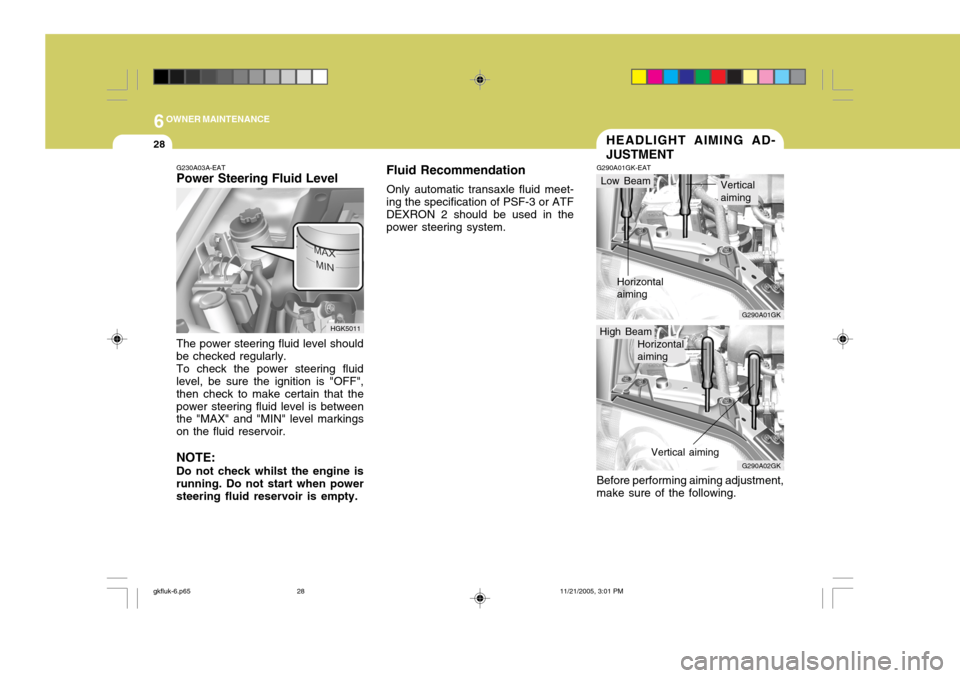
6OWNER MAINTENANCE
28
HGK5011
G230A03A-EAT Power Steering Fluid Level
Fluid Recommendation
Only automatic transaxle fluid meet-
ing the specification of PSF-3 or ATF DEXRON 2 should be used in thepower steering system.
The power steering fluid level shouldbe checked regularly. To check the power steering fluid level, be sure the ignition is "OFF", then check to make certain that thepower steering fluid level is between the "MAX" and "MIN" level markings on the fluid reservoir. NOTE: Do not check whilst the engine is running. Do not start when power steering fluid reservoir is empty.High Beam
G290A01GK
G290A01GK-EAT HEADLIGHT AIMING AD- JUSTMENT
Before performing aiming adjustment, make sure of the following.
G290A02GK
Low Beam
Horizontal aiming Verticalaiming
Horizontal aiming Vertical aiming
gkfluk-6.p65 11/21/2005, 3:01 PM
28
Page 447 of 478
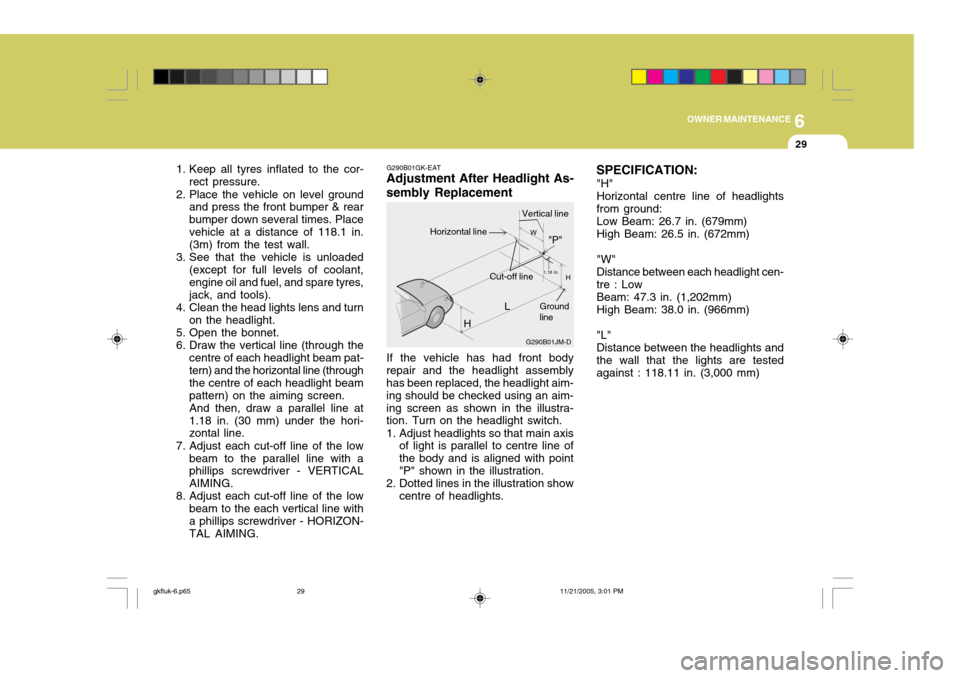
6
OWNER MAINTENANCE
29
G290B01GK-EAT
Adjustment After Headlight As- sembly Replacement
If the vehicle has had front body
repair and the headlight assembly has been replaced, the headlight aim- ing should be checked using an aim-ing screen as shown in the illustra- tion. Turn on the headlight switch.
1. Adjust headlights so that main axis of light is parallel to centre line of the body and is aligned with point"P" shown in the illustration.
2. Dotted lines in the illustration show centre of headlights. SPECIFICATION:
"H" Horizontal centre line of headlights from ground: Low Beam: 26.7 in. (679mm) High Beam: 26.5 in. (672mm) "W" Distance between each headlight cen- tre : Low Beam: 47.3 in. (1,202mm) High Beam: 38.0 in. (966mm) "L" Distance between the headlights and the wall that the lights are tested against : 118.11 in. (3,000 mm)
1. Keep all tyres inflated to the cor-
rect pressure.
2. Place the vehicle on level ground and press the front bumper & rearbumper down several times. Placevehicle at a distance of 118.1 in. (3m) from the test wall.
3. See that the vehicle is unloaded (except for full levels of coolant, engine oil and fuel, and spare tyres,jack, and tools).
4. Clean the head lights lens and turn on the headlight.
5. Open the bonnet.
6. Draw the vertical line (through the centre of each headlight beam pat- tern) and the horizontal line (through the centre of each headlight beampattern) on the aiming screen.And then, draw a parallel line at1.18 in. (30 mm) under the hori- zontal line.
7. Adjust each cut-off line of the low beam to the parallel line with aphillips screwdriver - VERTICAL AIMING.
8. Adjust each cut-off line of the low beam to the each vertical line witha phillips screwdriver - HORIZON- TAL AIMING. L
G290B01JM-D
W
H
H Cut-off line"P"
Vertical lineHorizontal line
Ground line
1.18 in.
gkfluk-6.p65
11/21/2005, 3:01 PM
29
Page 448 of 478
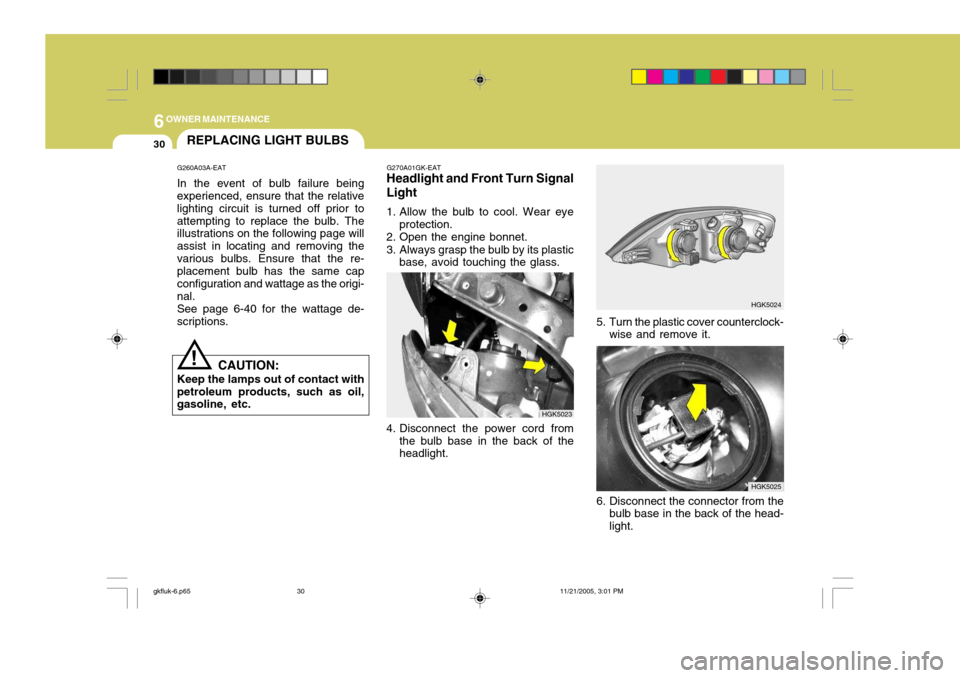
6OWNER MAINTENANCE
30REPLACING LIGHT BULBS
G260A03A-EAT In the event of bulb failure being experienced, ensure that the relative lighting circuit is turned off prior toattempting to replace the bulb. The illustrations on the following page will assist in locating and removing thevarious bulbs. Ensure that the re- placement bulb has the same cap configuration and wattage as the origi-nal.See page 6-40 for the wattage de-scriptions.
CAUTION:
Keep the lamps out of contact withpetroleum products, such as oil, gasoline, etc.
!
HGK5025
G270A01GK-EAT
Headlight and Front Turn Signal Light
1. Allow the bulb to cool. Wear eye
protection.
2. Open the engine bonnet.
3. Always grasp the bulb by its plastic base, avoid touching the glass.
HGK5024
5. Turn the plastic cover counterclock- wise and remove it.
4. Disconnect the power cord from the bulb base in the back of the headlight. HGK5023
6. Disconnect the connector from thebulb base in the back of the head- light.
gkfluk-6.p65 11/21/2005, 3:01 PM
30